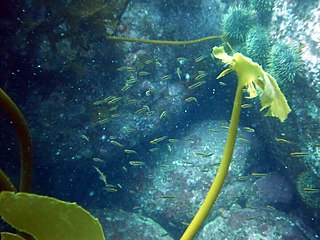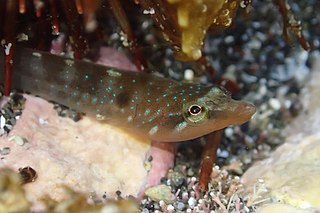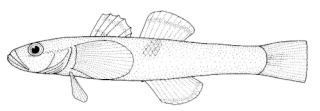
Notothenia microlepidota, the black cod or small-scaled cod, is a species of marine ray-finned fish, belonging to the family Nototheniidae, the notothens or cod icefishes. It is native to the Pacific waters around New Zealand and Macquarie Island. This species can reach a total length of 70 cm (28 in). It is a commercially important species.
Sir John McClelland (1805–1883) was a British medical doctor with interests in geology and biology, who worked for the East India Company.

The spectacled triplefin is a triplefin in the genus Ruanoho. It is commonly found around New Zealand from depths of a few metres to about 30 m, most common in reef areas of broken rock. Its length is between 4 and 8 cm and its head is flattened with large eyes surrounded by a dark band giving rise to its common name. The head and fins have a pattern of fine blue lines. Its large pectoral fins are used as props when resting on the bottom where it spends most of its time.

Yaldwyn's triplefin is a fish of the genus Notoclinops, found around the North Island of New Zealand from low water to depths of about 5 metres, most common in reef areas of broken rock, but nowhere common. Its length is between 4 and 8 centimetres. It is a pale yellow-brown with a faint orange tinge to the head, and two or three rows of small black dots on the flanks.

The oblique-swimming triplefin is a triplefin, found along the north east coast of the North Island of New Zealand from depths of about 5 m to 50 m. They are the only triplefins not to spend most of their time resting on the bottom, instead swimming in loose schools of up to hundreds of individuals above rocky reefs. When swimming their head is higher than the tail, giving rise to their common name.

The scaly-headed triplefin, Karalepis stewarti, is a triplefin, the only species in the genus Karalepis. It is endemic to New Zealand where it is found around North Island, South Island, the Three Kings Islands, Snares Island and Stewart Island. It is a nocturnal species It occurs at depths of about 5 to 30 metres, in reef areas of broken rock. The specific name honours Andy Stewart of the Department of Fishes at the National Museum of New Zealand.

The mottled triplefin is a triplefin of the genus Forsterygion, found around New Zealand at depths down to 30 m, in reef areas of broken rock. Its specific name honours Malcolm Francis of the Fisheries Research Centre in Wellington, New Zealand, who joined Hardy on his trips to collect specimens.

The New Zealand urchin clingfish is a clingfish. It is found around New Zealand wherever sea urchins are present. Its length is between 2 and 3 cm.

Scorpaena cardinalis, the eastern red scorpionfish, grandfather hapuku, cardinal scorpionfish, Cook's scorpionfish, Cook's rockcod, Kermadec scorpionfish, Northern scorpionfish, red scorpion fish, red scorpion-cod or Sandy-bay cod, is a species of marine ray-finned fish belonging to the family Scorpaenidae, the scorpionfishes. It is found in the southwestern Pacific Ocean.

Graham's gudgeon, Grahamichthys radiata, is a species of goby of the family Thalasseleotrididae, the only member of the genus Grahamichthys. This species is found in rock pools and in the neritic zone, to 50 metres (160 ft) in depth, where sand or mud is lies around and partially buries rocks, shells, or other objects. It is unusual for a goby, in that it lives in loose schools.

The Alert pigfish is a species of marine ray finned fish, a pigfish belonging to the family Congiopodidae. It is the only species in the monotypic genus Alertichthys. This species is endemic to the waters around New Zealand.
Gyrinomimus grahami is a flabby whalefish of the genus Gyrinomimus, found in all the southern oceans.

Codlets are a family, Bregmacerotidae, of cod-like fishes, containing the single genus Bregmaceros found in tropical and subtropical waters throughout the world. They are very small fishes and even the largest, B. lanceolatus, reaches only 11.5 cm (4.5 in) in length.

Rendahl's messmate is a pearlfish of the family Carapidae, found in the southwest Pacific Ocean around Australia and New Zealand at depths to 60 metres (200 ft). Its length is between 10 and 12 centimetres .The larvae has a long filament on its head which bears some resemblance to a siphonophore. These fish live within sponges. The specific name honours the Swedish naturalist and artist Hialmar Rendahl who collected the specimens in the Tasman Sea which were used by Gilbert Percy Whitley to describe this species.

The southern conger is a conger of the family Congridae, found in the eastern Indian Ocean and south-western Pacific Ocean, including southern Australia and New Zealand, at depths down to 100 m in broken rocky reef areas. Length is up to 2 m and weight may be up to 5 kg.

Helicolenus percoides, the reef ocean perch, coral cod, coral perch, Jock Stewart, kuriarki, ocean perch, red gurnard perch, red gurnard scorpionfish, red ocean perch, red perch, red rock perch, scarpee or sea perch, is a species of marine ray-finned fish belonging to the subfamily Sebastinae, part of the family Scorpaenidae. It is found in the southwestern Pacific Ocean.
Eustomias trewavasae, the deepsea dragonfish, is a small abyssal barbeled dragonfish of the family Stomiidae, found worldwide in tropical and subtropical oceans at depths down to 1,500 m. Its length is up to 26 centimetres (10 in) TL.
Antipodocottus galatheae, the Galathea sculpin, is a species of marine ray-finned fish belonging to the family Cottidae, the typical sculpins. This species found on the continental shelf around New Zealand. It has also been recorded off Tasmania, New South Wales and Queensland.

The New Zealand flathead, Bembrops morelandi, is a duckbill fish of the family Percophidae, subfamily Bembropinae, found only around New Zealand, at depths between 365 and 395 m. Their length is up to 20 cm.

Paranotothenia magellanica, also known as Magellanic rockcod, Maori cod, blue notothenia or orange throat notothen, is a species of marine ray-finned fish, belonging to the family Nototheniidae, the notothens or cod icefishes. It is native to the Southern Ocean. "Maori chief" and "black cod", sometimes used for this species, usually refer to fishes from the related genus Notothenia. Being a perciform fish, it is unrelated to the true cods of the order Gadiformes. This species is commercially important as a food fish.
















